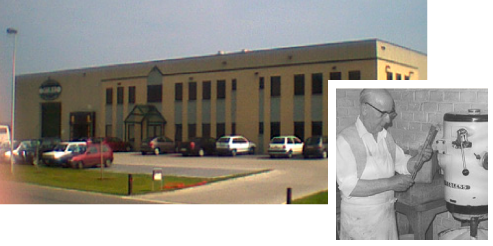For more than half a century, Carlier, a family business, has been making nougat by using the highest quality ingredients, in a wide variety of flavours. It all began in 1949: following the example of his father, a retail confectioner, Rodolphe Carlier decided to embark upon a career in manufacturing nougat, a market relatively lacking in competition compared to other confectionery sectors.

Owing everything in the beginning to his skill, the young man was assisted by his wife in producing mainly items to supply the retailers who invaded tourist sites during the summer. Within a short amount of time, however, Rodolphe Carlier succeeded in selling his nougat to wholesalers and in department stores, making it possible for his product to be sold (and bought!) throughout the whole year. The confectioner’s business figures began to rise: in 1975, the team numbered about thirty people and easily produced 400 kilos of nougat per day.
In 1972, Michel Carlier (Rodolphe Carlier’s son) joined the company. Today he is Managing Director. In 1986, it became necessary to leave the 300m² workshop in Anderlecht and move into a space three times that size in Ruisbroek.
Fifteen years later (2001), due to lack of space and a growth in our activities, we made the decision to build a 3000m² factory in the Saintes industrial estate, in compliance with HACCP standards.
Thanks to this new site and the continual growth of our sales in more and more diverse sectors such as the hotel/catering sector and chocolate-making, as well as rigorous efforts towards managing the organisation of our activities, due in part to norms imposed by the European Union and by an ever-more demanding clientele, we have been able to attain a daily production rate of +/- 3500 kilos with a workforce of 25 to 30 people, depending on the time of year. In 2011 we added 2000m² and our daily production now reaches +/- 5000kg.
.jpg)
.jpg)
.jpg)
.jpg)
.jpg)
.jpg)
.jpg)
.jpg)
.jpg)
.jpg)
Our nougat is made exclusively from natural products and contains no preservatives in any of the variety of flavours.
Production begins with a mixture of sugar and glucose syrup, which is brought to a high temperature and to which honey is added for certain types of nougat such as Montélimar nougat.
This mixture is then incorporated into egg whites or milk protein (depending upon the type of nougat) that have first been beaten to form stiff peaks. Once this has been achieved, we add a certain percentage of almonds, pistachios or candied fruits, depending upon the type of nougat being made.
.jpg)
.jpg)
-liggend.jpg)
.jpg)
.jpg)
.jpg)
This unctuous mixture is then poured onto a thin, unleavened paper and is covered with another layer of the same paper. It is then cut and packaged according to the wishes of our clients.
Our expertise and the strict use of traditional methods, combined with modern technology, allow us to produce different varieties of nougat, already enjoyed in many countries.
.jpg)
.jpg)
.jpg)
.jpg)
.jpg)
.jpg)
.jpg)
.jpg)
.jpg)
.jpg)
.jpg)
.jpg)
The origins of this confection date back to ancient times and can be traced to the other side of the Mediterranean, in the Orient, where women prepared it using almonds, honey and spices. It was also found in Greece, where it was made with walnuts and without spices, as well as in Marseilles, where it enjoyed widespread success until the XVIIth century.
This walnut-based cake was called nux gatum and nugo in langue d’oc. Domestically prepared, the nugo – the black nougat also called “nougat de Provence” – along with white nougat, created afterwards, were among the thirteen traditional desserts prepared at Christmas. The town of Montélimar and nugo would see their destinies cross when, in the XVIIth century, Olivier de Serre planted the first almond trees imported from Asia on his property located a few kilometres from Montélimar.
The people of Provence, attracted by the success he experienced, would follow his example and go on to develop plantations throughout the region. It is highly probable that over the course of the years, the idea was thus planted to replace the walnuts in nugo with the providential almond… It appears to have been in 1650 that the development of the recipe for white nougat was achieved with the addition of egg white to aerate and lighten the mixture. Nugo thus became nougat, without anyone today still knowing the name of its creator…
View the results of the Carlier solar panels
Live solar panel info